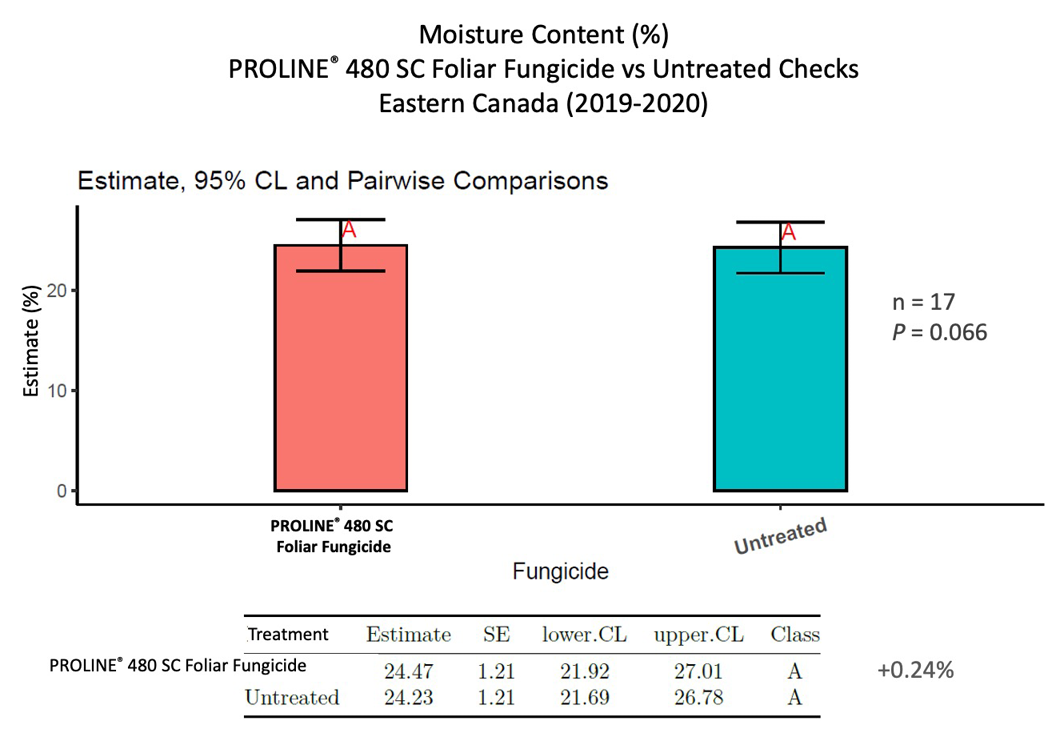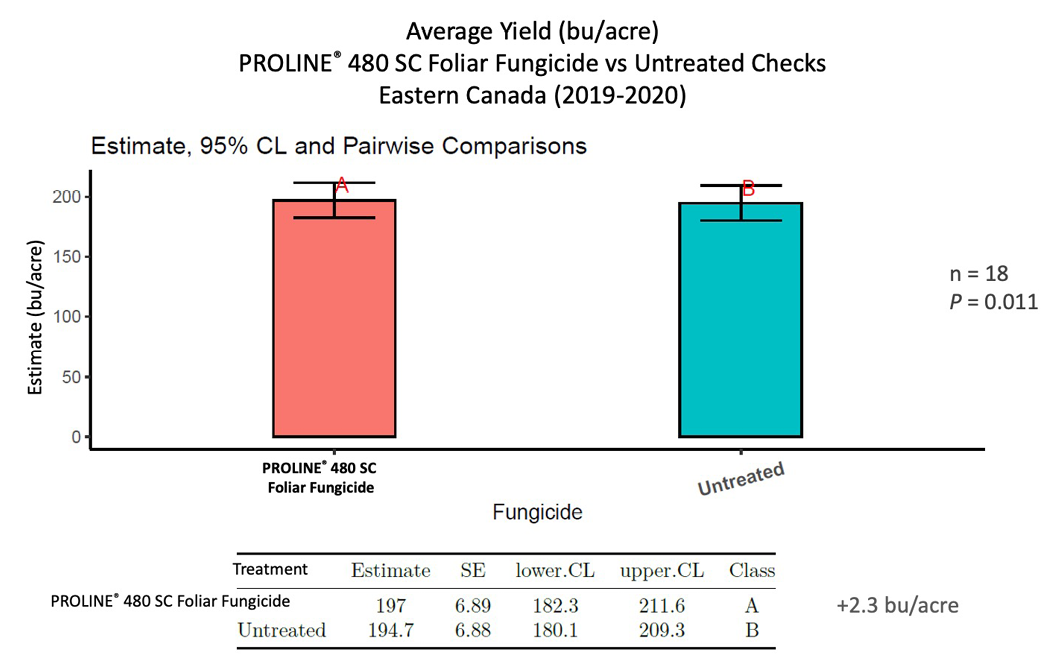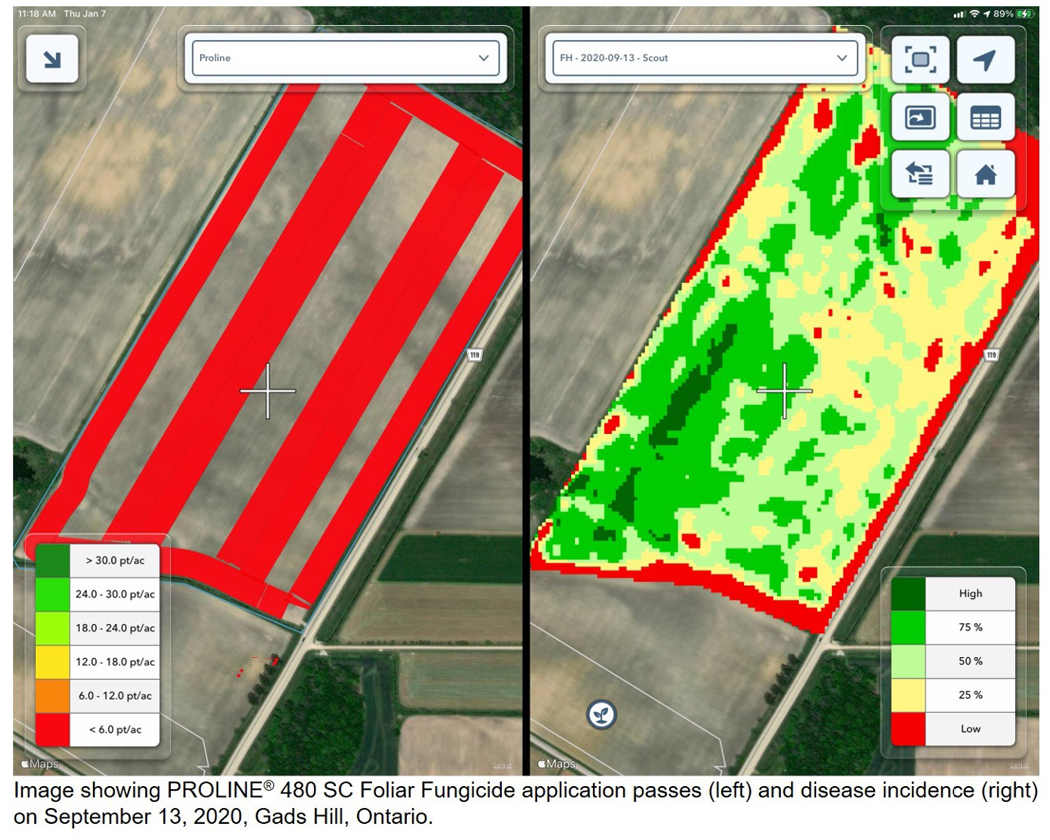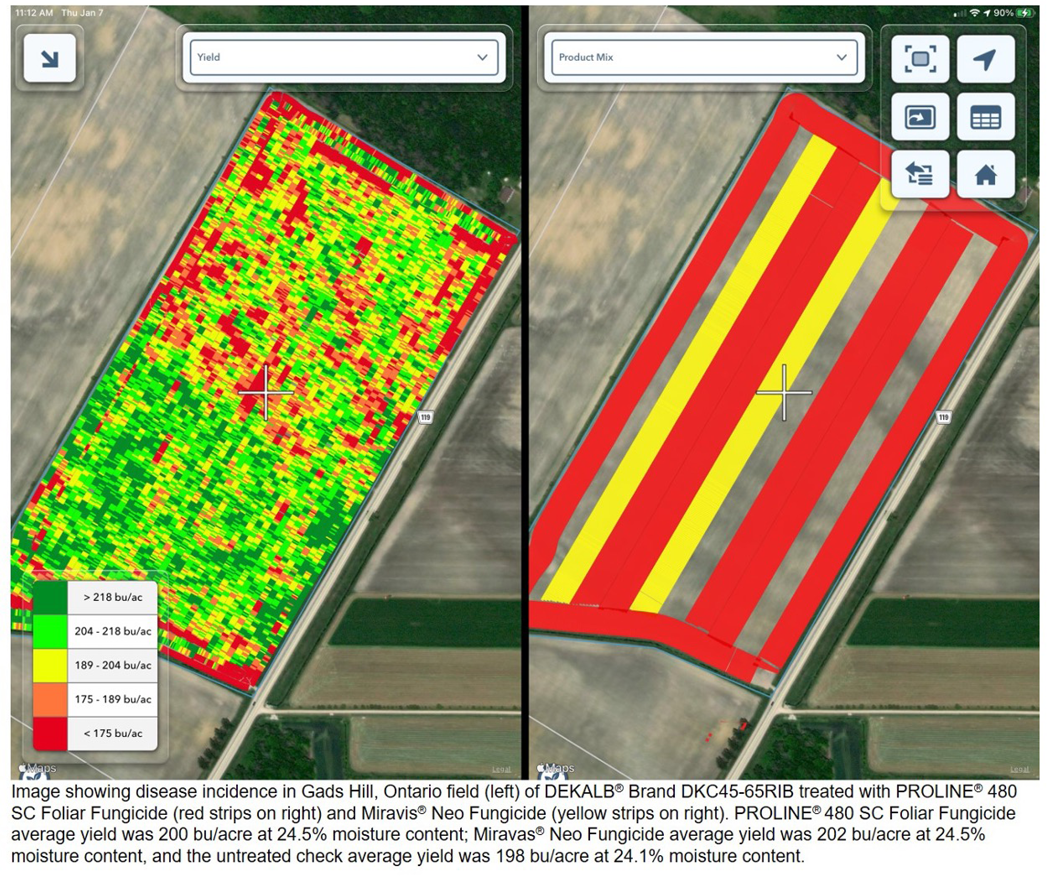Trial Objective
To demonstrate the fungal disease protection of PROLINE® 480 SC Foliar Fungicide on corn with the use of Climate FieldView™ Platform.
- PROLINE® 480 SC Foliar Fungicide is a Group 3 (prothiconazole) fungicide for the control or suppression of labeled diseases.
- Corn yield potential can be reduced when fungal diseases develop.
Experiment/Trial Design
- Plant a preferred DEKALB® brand corn product from the provided product list and map planting in Climate FieldView™ Platform.
- Utilize field-scale (maximum of 40 acres) Market Development Agronomist (MDA) trial to demonstrate on-farm effectiveness and benefits of PROLINE® 480 SC Foliar Fungicide. Applications to be mapped in Climate FieldView™ Platform.
- Within the trial total acreage, a minimum of two untreated passes (untreated checks, UTC) selected with the use of Climate FieldView™ Field Health imagery, should be left for comparison with the fungicide-treated acreage. UTC passes should be a minimum of two acres, combine width, and allow for a minimum of four combine header passes.
- 60 feet (sectional control) wide x 1500 feet long
- 100 feet wide x 900 feet long
- 120 feet wide x 750 feet long
- Ideally, fungicide applications should occur pre-tassel up to early R1 growth stage; however, fungicide applications can occur when western bean cutworm (WBC) insecticides are applied. Cooperators spraying to control WBC should spray the UTC areas with insecticide.
- Treatments (Table 1):
- Spray 125 ml/acre (316 ml/hectare) of PROLINE® 480 SC Foliar Fungicide over the areas covering treatment 2.
- Minimum water volume of 10 gal/acre (100 L/hectare). 19.2 to 20 gal/acre (180 to 200 L/hectare) is preferable.
- No adjuvant.
- Spray 1/2 of tank.
Table 1. Treatments and rates
|
Treatment
|
Product
|
Rate
|
VT
|
R1
|
|
1
|
Untreated Check (UTC)
|
NA
|
NA
|
NA
|
|
2
|
PROLINE® 480 SC Foliar Fungicide
|
125 ml/acre (316 ml/hectare)
|
X
|
X
|
|
3
|
Miravis® Neo Fungicide (at least one/MDA trial)
|
404.7 ml/acre (1 L/hectare)
|
Optional
|
|
|
404.7 ml/acre (1 L/hectare)
|
|
Optional
|
- Field layout examples:

Figure 1. Field layout example 1.

Figure 2. Field layout example 2.
- Trial Evaluations
- Plan unmanned aerial vehicle (UAV) flights to catch interesting situations.
- Ratings and evaluations (walk field and evaluate representative areas for each treatment).
- Fungal disease severity (FSEV) rating at R3 to R5 growth stages (Figure 3).
- Staygreen (STGRN) rating at R5 growth stage (Figure 4).
- Ear rot (Gibberella) severity rating (ERSR) at R5 growth stage (Figure 5).
- Root lodging percent (RTLP) at harvest.
- Stalk lodging percent (STLP) at harvest.
- Intactness (INT) at harvest.
- Percent moisture content (MST) at harvest.
- Optional - test weight (TWT) at harvest.
- Collect grain samples for lab analysis of deoxynivalenol (DON) and zearalenone (MDIC) at harvest.
- Record field notes in EXCEL file.
- Field should be harvested with one combine. At minimum, UTC and fungicide strips on each side of the UTC.

Figure 3. Fungal disease severity rating scale.

Figure 4. Staygreen rating scale.

Figure 5. Ear rot (Gibberella) severity rating scale.
Understanding the Results
- Climate FieldView™ Platform provided beneficial images and information to support the use of foliar fungicides.
PROLINE® 480 SC Foliar Fungicide
- Grain from treated corn contained slightly more moisture (0.24%) than untreated corn (Figure 6).
- Average yield was 2.3 bu/acre greater for treated corn versus untreated corn (Figure 7).
- Treated corn showed a reduction in the ppm of DON versus untreated corn (0.235 and 0.526, respectively) (Figure 8).
- Treated corn with Gibberella ear rot pressure showed a yield increase of 4.8 bu/acre versus untreated corn (Figure 12).

Figure 6. PROLINE® 480 SC Foliar Fungicide-treated corn had an average of 0.24% more moisture content than the untreated checks.

Figure 7. PROLINE® 480 SC Foliar Fungicide-treated corn had an average of 2.3 bu/acre more yield than the untreated checks.

Figure 8. Average yield delta for each corn product at each Eastern Canada MDA location (2019-2021) treated with PROLINE® 480 SC Foliar Fungicide.

Figure 9. PROLINE® 480 SC Foliar Fungicide showed an average 55.3% reduction in ppm of DON compared to the untreated checks (2019-2021).

Figure 10. PROLINE® 480 SC Foliar Fungicide showed an average 60.3% reduction in ppm of DON compared to the untreated checks (2019-2020).

Figure 11. Effect of PROLINE® 480 SC Foliar Fungicide on average moisture content, DON, and yield (2019-2020) in Eastern Canada MDA Trials where Gibberella ear rot infestation was absent compared to the presence of Gibberella.

Figure 12. Effect of PROLINE® 480 SC Foliar Fungicide on average yield (2019-2020) in Eastern Canada MDA Trials where Gibberella ear rot infestation was present.

Figure 13. Effect of PROLINE® 480 SC Foliar Fungicide on average ppm of DON (2019-2020) in Eastern Canada MDA Trials where Gibberella ear rot infestation was present.

Figure 14. Climate FieldView™ Platform image of PROLINE® 480 SC Foliar Fungicide application passes and disease incidence on August 22, 2020 at Gads Hill, Ontario.

Figure 15. Climate FieldView™ Platform image of PROLINE® 480 SC Foliar Fungicide application passes and disease incidence on September 3, 2020 at Gads Hill, Ontario.

Figure 16. Climate FieldView™ Platform image of PROLINE® 480 SC Foliar Fungicide application passes and disease incidence on September 13, 2020 at Gads Hill, Ontario.

Figure 17. Climate FieldView™ Platform image of Miravis® Neo fungicide application passes and disease incidence on September 13, 2020 at Gads Hill, Ontario.

Figure 18. Climate FieldView™ Platform image comparison of disease incidence in field treated with PROLINE® 480 SC Foliar Fungicide and Miravis® Neo Fungicide. Average yield and moisture content for the two treatments was similar.

Figure 19. Climate FieldView™ Platform images of field treated with PROLINE® 480 SC Foliar Fungicide.

Figure 20. Climate FieldView™ Platform imagery of field treated with PROLINE® 480 SC Foliar Fungicide.
Key Learnings
- PROLINE® 480 SC Foliar Fungicide helps maintain grain quality in the presence of pathogens that cause DON and Gibberella ear rot to develop.
Legal Statements
The information discussed in this report is from a multiple site, replicated demonstration. This informational piece is designed to report the results of this demonstration and is not intended to infer any confirmed trends. Please use this information accordingly.
Services and products offered by The Climate Corporation are subject to the customer agreeing to our Terms of Service. Our services provide estimates or recommendations based on models. These do not guarantee results. Before making financial, risk management and farming decisions, agronomists, commodities brokers and other service professionals should be consulted. More information at https://climatefieldview.ca/legal/disclaimer. FieldView™ is a registered trademark of The Climate Corporation. Used under license. Bayer is a member of Excellence Through Stewardship® (ETS). Bayer products are commercialized in accordance with ETS Product Launch Stewardship Guidance, and in compliance with Bayer’s Policy for Commercialization of Biotechnology-Derived Plant Products in Commodity Crops. These products have been approved for import into key export markets with functioning regulatory systems. Any crop or material produced from these products can only be exported to, or used, processed or sold in countries where all necessary regulatory approvals have been granted. It is a violation of national and international law to move material containing biotech traits across boundaries into nations where import is not permitted. Growers should talk to their grain handler or product purchaser to confirm their buying position for these products. Excellence Through Stewardship® is a registered trademark of Excellence Through Stewardship.
ALWAYS READ AND FOLLOW PESTICIDE LABEL DIRECTIONS. Performance may vary from location to location and from year to year, as local growing, soil and weather conditions may vary. Growers should evaluate data from multiple locations and years whenever possible and should consider the impacts of these conditions on the grower’s fields.
Bayer, Bayer Cross, DEKALB®, Proline® and RIB Complete® are registered trademarks of Bayer Group. Used under license. All other trademarks are the property of their respective owners. Bayer CropScience Inc. is a member of CropLife Canada. ©2022 Bayer Group. All rights reserved.1211_32100